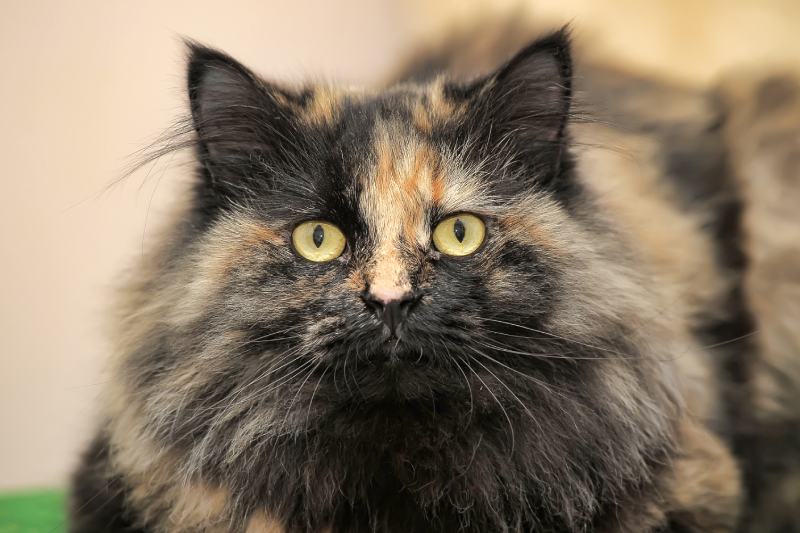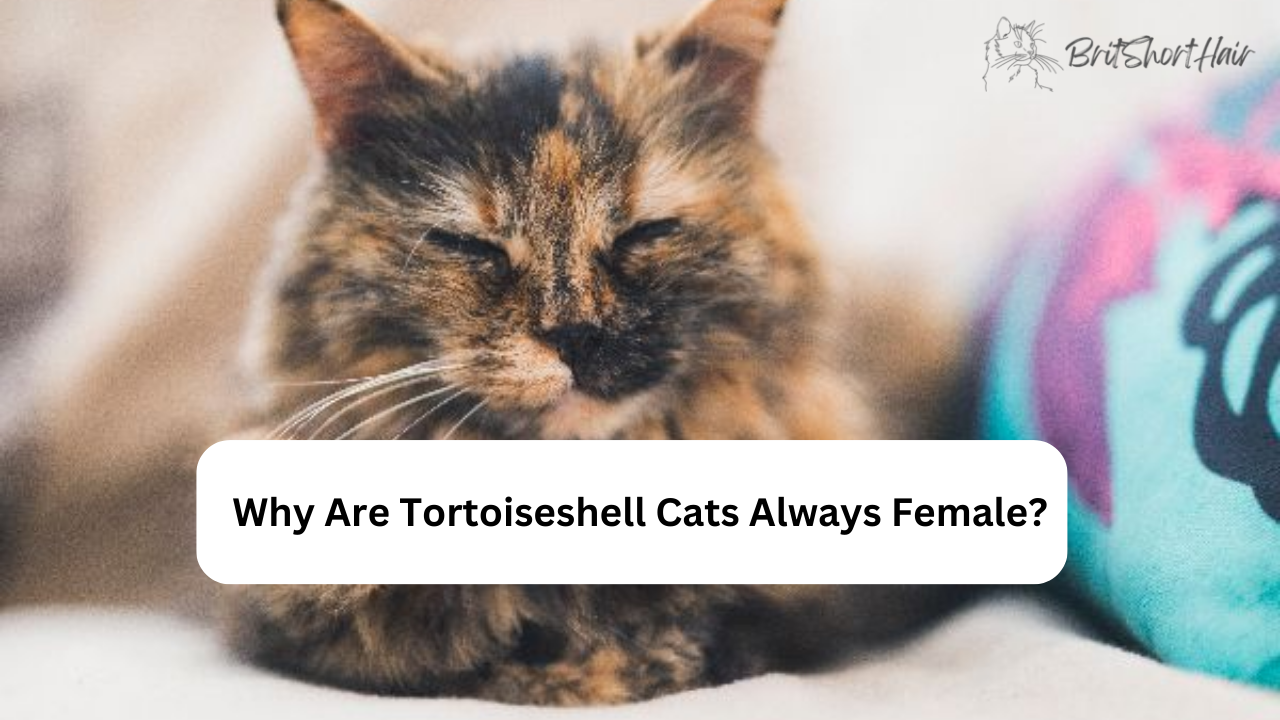Introduction

Tortoiseshell cats’ intriguing and vivid coat patterns have captivated cat enthusiasts for years. One noteworthy trait of tortoiseshell cats is that they are mostly female. In this essay, we will investigate the genetic complexities that underpin tortoiseshell coat patterns and offer insight into the reasons for their female dominance.
Understanding Coat Colors in Cats
Basic understanding of coat color inheritance
Understanding how cats’ coat colors are inherited is extremely fascinating. It entails delving into the subtle ways in which genes influence the color of a cat’s hair. This process is far from straightforward, as it involves the transmission of genetic information from parents to their offspring. There are several genes at work in cats’ genetic composition, each of which controls the creation and distribution of colors within the hair follicles. These pigments, in turn, determine the distinct color and pattern seen in a cat’s coat. It’s wonderful to consider how these genetic elements interact to produce the lovely and unique range of coat colors we see in our feline pets.
The role of genes in determining coat color
A complicated interaction of genes determines the color of a cat’s coat. These genes regulate the generation and distribution of pigments like eumelanin and pheomelanin, which are responsible for the many colors and shades seen in a cat’s coat. The presence or absence of particular genes, as well as their interactions, affect the type and quantity of pigments generated and deposited in hair follicles.
Each gene involved in coat color inheritance has a distinct role. Some genes control the intensity and saturation of pigments, resulting in different shades of black, brown, red, and orange. Other genes control pigment dispersion, resulting in patterns such as tabby stripes, spots, or tortoiseshell patches.
It’s fascinating to consider how these genes interact to produce the wide range of coat colors and patterns found in cats. Each cat acquires a unique coat hue due to a combination of genes from its parents. This variety enhances the attractiveness and uniqueness of each feline friend.
Variations in coat color patterns
The world of cat coat color patterns is intriguing, and full of tremendous variation and beauty. Specific genes responsible for pattern creation impact the patterns that appear on a cat’s coat, whether they are solid colors, tabby stripes, spots, or other particular patterns. These genes collaborate with the pigmentation genes to produce an infinite number of coat color patterns. The interaction of these genes results in an enthralling tapestry of colors and patterns that make each cat really unique. It’s fascinating to consider how these genetic elements interact to create the magnificent coat color patterns we see in our feline pals.
Tortoiseshell Coat Pattern
Characteristics of the Tortoiseshell Coat Pattern
The tortoiseshell coat pattern is truly unique and visually appealing. Cats have a special feature that results in a mesmerising mosaic-like pattern on their fur. Because of its intriguing and enchanting appearance, this one-of-a-kind coat pattern has captured the hearts of cat lovers all around the world.
The Patchwork of Colors
The tortoiseshell coat pattern is distinguished by the patchwork of colours that adorns a cat’s fur. This design typically features a compelling blend of black and orange tones, resulting in a visually pleasing fusion. The remarkable aspect is that each tortoiseshell cat has a unique distribution of these colours, resulting in a wide range of individual patterns. Some cats have big patches of black or orange, but others have a more balanced and uniformly dispersed colour pattern. This originality contributes to each tortoiseshell cat’s charm and uniqueness, making them really special and engaging companions.
The Genetics of Tortoiseshell Cats
The role of sex chromosomes in coat color determination
Understanding the biology of the tortoiseshell coat pattern in cats is very fascinating. It centres around the role of sex chromosomes in coat colour determination, which is somewhat different from how it works in humans and many other mammals.
X and Y chromosomes and their impact on coat color
The process through which coat colour is determined in cats is pretty fascinating. It all comes down to the sex chromosomal variations between males and females. Male cats have one X and one Y chromosome (XY), whereas female cats have two X chromosomes (XX). The genes that regulate coat colour are found on the X chromosome.
Female cats thus inherit two copies of these coat colour genes, one from each parent. Male cats, on the other hand, only inherit a single copy because they only have one X chromosome. The chromosomal makeup difference between males and females has important ramifications for how coat colour is inherited and expressed in cats.
Females have two X chromosomes, which gives them more genetic material to decide their coat colour. They can inherit distinct versions of these coat colour genes, resulting in a greater spectrum of colours and patterns. With only one X chromosome, male cats have less genetic material to work with when it comes to coat colour.
The significance of the X-linked coat color gene
A unique gene termed the X-linked coat colour gene determines the tortoiseshell coat pattern in cats. There are two variants of this gene: one for orange colour (O) and one for non-orange colour (o). The presence or absence of the orange gene influences whether a cat’s coat will be orange or non-orange.
The interplay of these two gene variants results in the unusual coat pattern in female tortoiseshell cats, which have two X chromosomes. Each X chromosome can have either the orange or non-orange gene variation, resulting in patches of both black and orange fur. The precise combination of these colours results in the stunning mosaic-like pattern that marks the tortoiseshell coat.
Male tortoiseshell cats, on the other hand, are extremely unusual because they need an extra X chromosome, such as XXY or XYY, to acquire both the orange and non-orange gene variations. Male tortoiseshell cats do appear on occasion due to these chromosomal anomalies, but they are extremely rare.
X-Inactivation and Coat Color
When it comes to coat colour expression in female cats, a fascinating phenomenon known as X-inactivation occurs. This procedure is very remarkable because it ensures that the genetic information carried by female cats’ two X chromosomes is balanced and managed. We can learn a lot about how coat colours are inherited in these charming feline companions by studying how X-inactivation works.
X-Inactivation Process in Female Cats
During the early phases of female cat development, an intriguing mechanism known as X-inactivation occurs. This method ensures that only one of the two X chromosomes is active and functional in each cell, while the other X chromosome becomes dormant. This dormant X chromosome condenses into a structure known as a Barr body, which remains silent and inactive throughout the cat’s life. It’s fascinating to see how this natural process contributes to the right balance of X chromosome activity in each cell of a female cat’s body.
How X-Inactivation Affects Coat Color Expression
The expression of coat colours in female cats is greatly influenced by X-inactivation. When we consider tortoiseshell cats, this process becomes much more fascinating. The orange and non-orange gene variations on the X chromosomes are critical in determining the coat colour pattern in these cats.
Because of X-inactivation, some cells in a tortoiseshell cat’s body will express the orange gene, while others will express the non-orange gene. This causes patches of fur to appear in either orange or non-orange colours. The combination and arrangement of these patches results in a dazzling array of colours covering the cat’s coat, resulting in a gorgeous and distinct tortoiseshell pattern. It’s very amazing how X-inactivation effects the distinct coat colour patterns that make tortoiseshell cats so appealing.
Reasons Behind Tortoiseshell Cats Being Female
The fact that tortoiseshell cats are predominantly female is due to their unique genetic composition. Female cats have two X chromosomes, allowing them to inherit distinct combinations of coat colour genes on each chromosome. Because of their unique genetic ancestry, their fur expresses many colours, giving rise to the gorgeous and complicated tortoiseshell pattern.
Male cats, on the other hand, only have one X chromosome, restricting their ability to have the tortoiseshell coat pattern. As a result, male tortoiseshell cats are extremely unusual and frequently require genetic defects such as XXY or XXYY chromosomal disorders to produce this distinctive coat pattern. These chromosomal mutations are outliers to the norm and account for the occurrence of male tortoiseshell cats on occasion.
Exceptions to the Rule
Male tortoiseshell cats are extremely unusual, but there have been a few confirmed exceptions. Genetic mutations or chromosomal abnormalities that differ from the standard XX or XY chromosomal configuration are frequently blamed for these occurrences. The occurrence of male tortoiseshell cats highlights the complex and sometimes unforeseen nature of genetic variables that impact coat colour patterns in felines. It emphasises the complexities of genetics and the likelihood of unique variants occurring, even in the area of cat coat colours.
Conclusion
To summarise, learning about the genetics of tortoiseshell cats reveals the fascinating dynamics of sex chromosomes and X-inactivation. Because female cats have two X chromosomes, a diverse set of coat colour genes can be expressed, resulting in the beautiful and recognisable tortoiseshell pattern. The scarcity of male tortoiseshell cats, as well as the odd outliers, emphasise the complexities and intricacies of coat colour inheritance. Taking the time to admire tortoiseshell cats’ beauty and originality strengthens our attraction and admiration for these enchanting feline companions. They attest to the incredible diversity and splendour of nature’s genetic patchwork.
hey we have a lot of information on cats you can check out by clicking Bristhorthair.com
wants to follow us on social media

